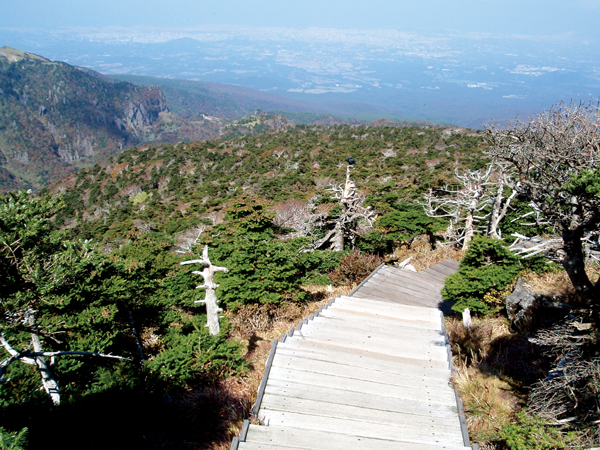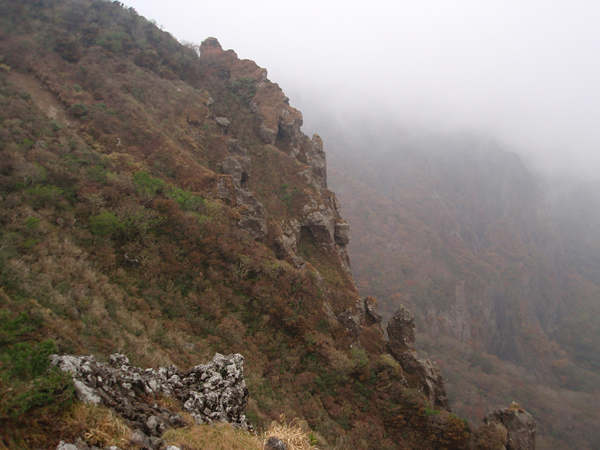
- Updated 2024.4.24 17:16
- All Articles
-
member
icon
-
facebook
cursor
-
twitter
cursor
|
TravelHiking |
Discover the grandeur of Mt. Halla's trailsThe latest of our Hike Jeju series describes the mountain's main routes |
|
Lace up and walk on. Hallasan National Park has eight official trails. All surpass quality expectations for the time and effort needed to invest in seeing Jeju’s varied nature during any of the four seasons. As autumn colors are peaking, soon to yield to winter, get out and see what the island’s interior provides. The following trails are ranked in order of preference, concluding with recommendations for the three best one-way, day-long hikes.
| |
 |
|
| ▲ Photo by Steve Oberhauser |
(1) Gwaneumsa
This is Hallasan National Park’s premier hiking trail and the roughest and toughest climb to the peak, Baenokdam, at 8.7 kilometers total length.
The reason to go is the area between Samgakbong (Triangle Peak) and the valley where the Yonggingak shelter once stood. In between a stunning suspension bridge provides a connection for hikers. Four different, distinct, and deft landscapes are present in the valley making you constantly turn your head for 360-degree views.
The last few kilometer stretch to the peak competes for impressiveness in a physical exertion workout and stunning panoramas, especially in the deep snows and throes of winter.
Gwaneumsa also boasts a 1,000-person capacity campground at its base, an incredibly large temple by the same name further east, Tamna Valley, and the first 1.5-km run is the Gwaneumsa Zone Discovery Trail, with interpretive and educational signs familiarizing a learner to the natural area.
| |
 |
|
| ▲ Photo by Steve Oberhauser |
(2) Eorimok
A first encounter with Witsae Oreum [volcanic cone] should be reached via Eorimok.
Before even setting off on the journey, the Eorimok Visitor Center is intelligent and inviting. Various interactive displays are present on two floors for all ages and abilities. This is the best place to learn in-depth about Mt. Halla in English on the subjects of flora, fauna, and geology.
There are many small wonders on this 4.7-km path to the 1,800-meter Witsae Oreum, where a manned rest shelter offers noodles and other snacks. To get there, a trekker goes through an oak tree forest ascent toward Sajebi Hill and its wooden walkway, in addition to reaching Manse Park Overlook. The red azalea blossoms in the spring blanket the wide expanse at top. Also, nice babbling creeks run their course and at least one spring water drinking opportunity is present.
| |
 |
|
| ▲ Photo by Steve Oberhauser |
(3) Dullaegil
The national park’s rendition of an Olle course is here.
The first of many trails that will cut through the base, with minimal climbing. With less exhaustion, the focus can be more reflective on just nature with a level walk. Few people use Dullaegil (nine kms in length), especially on the weekdays.
Five key strengths make up this route. First, get a history lesson of the anti-Japanese movement in 1918 at the start as the trail departs from Beopjeongsa temple. On the trail, witness a dense camellia stretch, remnants of a charcoal kiln and Si Oreum’s 4.3 fortified rock station. Near the end, a hiker has the option of climbing Si Oreum to a narrow and framed view of Mt. Halla’s crown.
The future of Mt. Halla can be felt walking this stretch to see interiors rarely seen.
| |
 |
|
| ▲ Photo by Steve Oberhauser |
(4) Donnaeko
The least walked way up Mt. Halla reopened in 2009 after a 15-year hiatus for environmental protection.
The first 5.3 kms is primarily dense forest and an uphill climb; to seek out each 100-meter increase in elevation, check the rock-etched signs. After, Pyeonggwe Shelter peeks out and the world opens up with incredible backdoor views of Mt. Halla’s top. The course ends at the South Wall Fork and the Nambyeok Watershed Observatory.
However, there is an extra 2.1-km run, known as the fork in the Nambyeok, which links up to Witsae Oreum, and it is a sub-alpine shrubbery zone. In total, Donnaeko extends 9.1 kms with various views near the crest of Seogwipo’s coast.
Of all the trails in the park, nature can be heard and seen, to some extent, best here. Roe deer and their subsequent calls are ever-present at twilight.
| |
 |
|
| ▲ Photo by Steve Oberhauser |
(5) Yeongsil
A short, 3.7-km path that finds Eorimok at Witsae Oreum.
The highlight is the collection of rocks in Yeongsil Giam, also known as the 500 Generals or Buddha’s 500 Disciples, depending on what mythological story is presented. In this area, springtime is the best, with rain as water flows provide an enlightening scene. Autumn details full radiant blotches of color change.
The main path covers Korean fir trees to alpine meadows.
Little known and used is the short offshoot trail from the Yeongsil ticket office to Jonjaam temple. Equally as impressive with the main trail as this section sits and winds in Bulrae Oreum’s valley, at roughly 1,300 meters, all without any unnatural external noise or light.
| |
 |
|
| ▲ Photo by Steve Oberhauser |
(6) Seongpanak
The longest of Mt. Halla’s trails, Seongpanak hits 9.6 kms en route to the 1,950-meter peak, as it meets with Gwaneumsa.
A very popular course in all seasons, two main attractions await. First is newly-opened Sara Oreum, with its crater lake (if full) and observatory, taking in a 40-minute side hike. The area provides a brief break from a hectic rush of people climbing to the top.
Second of Seongpanak’s features is Jindallaebat, a break-point shelter and store before starting the final stretch up to Baenokdam.
Hordes of tour buses start at Seongpanak, hikers go up and come down Gwaneumsa, to get picked up at that base.
| |
 |
|
| ▲ Photo by Steve Oberhauser |
(Hidden paths) Eoseongsaengak and Seokgulam
● Eoseongsaengak is accessible next to the Eorimok Visitor Center. Only 1.3 kms, Eoseongsaeng is a scoria cone (or cinder cone) and reaches 1,169 meters. At the top rest area is an incredible view of Mt. Halla’s summit and Eorimok Valley. Further, on a clear day, Chujado, Biyangdo, and Seongsan Sunrise Peak are all possible to witness. Wide wood stairs mostly lead the way.
● Seokgulam starts close to Cheonwangsa temple, well west of Gwaneumsa. Short, at 1.5 kms, the trail is located in Aheunahhopgal Valley. Rising quickly, at the end it drops down to reach an interestingly designed and intensely candle-lit Seokgulam temple. During brief stretches, the course is narrow and steep rocks have to be traversed. However, the end result is worth the effort.
| |
 |
|
| ▲ Photo by Steve Oberhauser |
Top 3 one-way, day-long Mt. Halla hikes
First
Start at sunrise and ascend Gwaneumsa, while spending a lot of rest time at the area around Yonggingak, before reaching the top of Baenokdam. Time it right, about three hours before sunset, start the descent of Seongpanak, making sure to hit Sara Oreum as well (18.3 kms total).
Second
Start one hour after sunrise and climb Eoseungsaengak. After, enjoy two hours at the Eorimok Visitor Center before ascending Eorimok to Witsae Oreum and head down Yeongsil, ending at the last stretch in twilight walking to and from Jonjaam temple (about 15 kms total).
Third
Start at sunrise to Jonjaam temple and back to go up Yeongsil. Take a lot of time at Witsae Oreum, and on the 2.1-km stretch of the fork in the Nambyeok, which connects to Donnaeko. Slowly descend that course. The later the better, as nature will come out in full force as sunset approaches (about 15 kms total).
|
|
|
|
|
|
|
|
ⓒ Jeju Weekly 2009 (http://www.jejuweekly.net)
All materials on this site are protected under the Korean Copyright Law and may not be reproduced, distributed, transmitted, displayed, published without the prior consent of Jeju Weekly. |
|
|
|
|
| Jeju-Asia's No.1 for Cruise |
|
|
|
Title:The jeju Weekly(제주위클리) | Mail to editor@jejuweekly.net | Phone: +82-64-724-7776 Fax: +82-64-724-7796
#503, 36-1, Seogwang-ro, Jeju-si, Jeju-do, Korea, 63148
Registration Number: Jeju, Ah01158(제주,아01158) | Date of Registration: November 10,2022 | Publisher&Editor : Hee Tak Ko | Youth policy: Hee Tak Ko
Copyright ⓒ 2009 All materials on this site are protected under the Korean Copyright Law and may not be reproduced, distributed, transmitted, displayed, published
without the prior consent of jeju weekly.com.

|



























